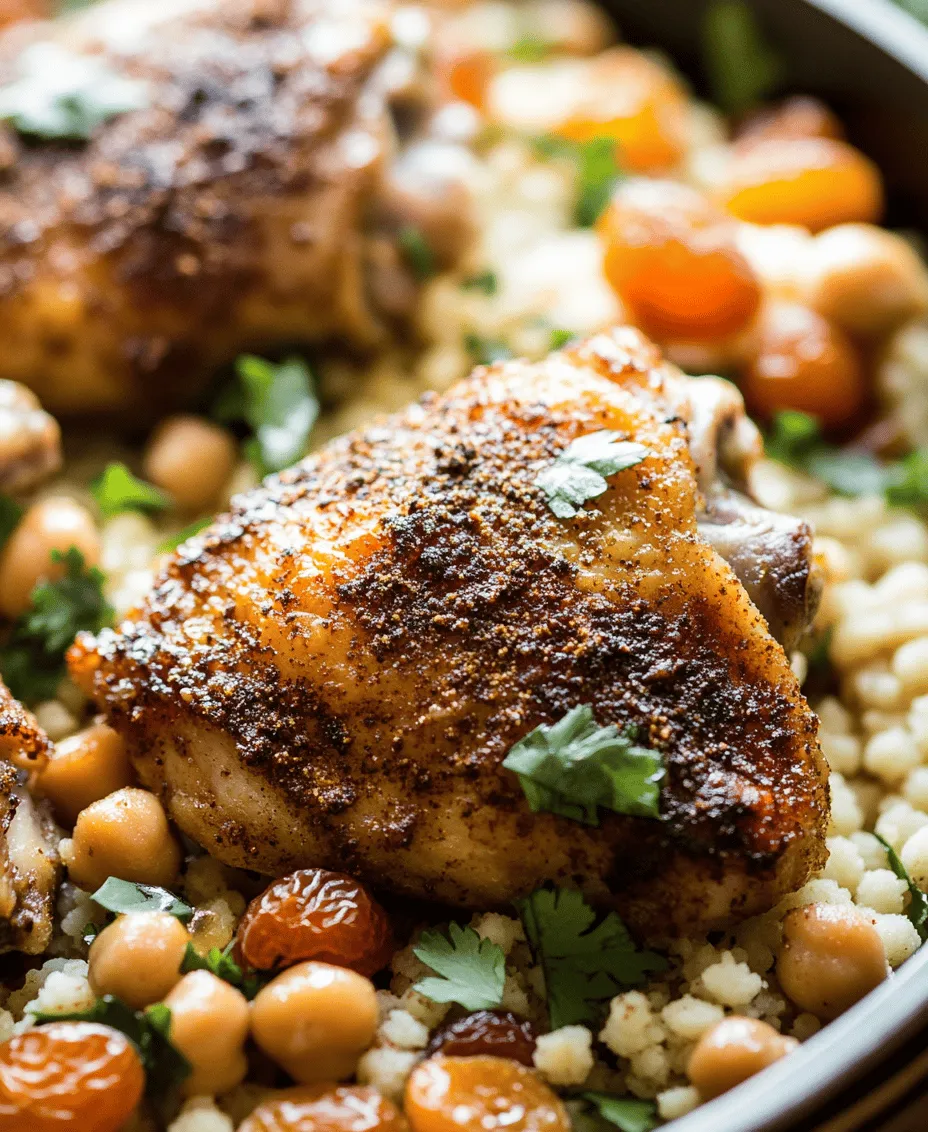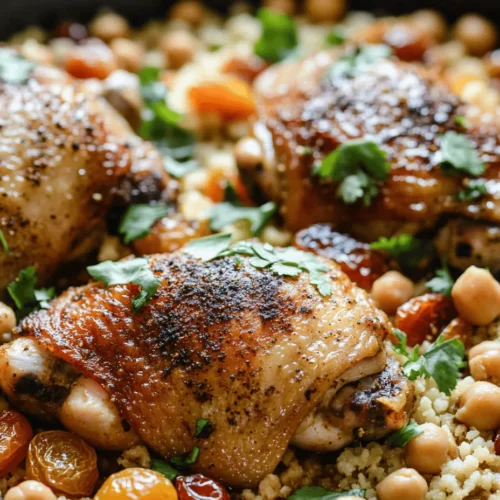Moroccan cuisine is a vibrant tapestry woven from a rich history of trade, cultural exchange, and diverse culinary influences. The aromatic spices and bold flavors typical of this cuisine transport you to the colorful souks of Marrakech, where the scent of spices fills the air. Among the many dishes that exemplify this culinary artistry, Moroccan Spiced Chicken stands out as a favorite. This recipe not only highlights the tender juiciness of chicken thighs but also showcases a stunning array of spices that create a dish that is both comforting and exotic. In this article, we will delve into the origins of Moroccan cuisine, the significance of each ingredient in this recipe, and provide a step-by-step guide to creating this delicious meal that is sure to impress your family and friends.
The Rich History of Moroccan Cuisine
To truly appreciate Moroccan Spiced Chicken, it’s essential to understand the historical context of Moroccan cuisine. Nestled between Europe, the Middle East, and Africa, Morocco has been a crossroads for various cultures and civilizations, including the Berbers, Arabs, and French. Each of these influences has left its mark on Moroccan cooking, creating a distinctive culinary style that is both diverse and rich.
The roots of Moroccan culinary traditions can be traced back to ancient times, when the Berbers used local ingredients and spices to craft meals that were both nutritious and flavorful. As trade routes opened, spices such as saffron, cumin, coriander, and cinnamon began to flow into Morocco from distant lands, enriching the local cuisine. Each spice not only adds flavor but also carries with it a story of cultural exchange and history.
Understanding Moroccan cuisine also requires an appreciation of its cultural diversity. The fusion of flavors and techniques reflects the various influences that have shaped the country over centuries. For example, the use of preserved lemons and olives is a nod to the Mediterranean heritage, while the sweet and savory combinations found in tagines reflect Arab influences. This culinary blending is what makes Moroccan cuisine so unique and exciting, and it is beautifully exemplified in the Moroccan Spiced Chicken recipe.
Ingredients Breakdown for Moroccan Spiced Chicken
When it comes to Moroccan Spiced Chicken, the magic truly lies in the ingredients. Each component plays a vital role in creating the rich tapestry of flavors that characterize this dish. Here’s a closer look at the key ingredients that elevate this recipe:
– Chicken Thighs: The star of the show, chicken thighs are preferred for their tender, juicy texture and rich flavor. Unlike chicken breasts, which can dry out quickly, thighs remain moist during cooking, making them perfect for slow-braising or marinating. Their higher fat content enhances the overall richness of the dish.
– Spices: Moroccan cuisine is synonymous with an array of spices that create depth and complexity. Key spices such as cumin, coriander, cinnamon, and paprika not only add flavor but also bring warmth and aroma to the dish. Cumin and coriander are fundamental to Moroccan cooking, imparting earthy notes, while cinnamon adds a sweet warmth that balances the spices.
– Fresh Ingredients: Aromatics like garlic, ginger, and onions are essential for building flavor. Garlic provides a pungent kick, while ginger adds a zesty brightness. Onions are sautéed until golden, creating a sweet base that enhances the overall dish. Fresh herbs like cilantro and parsley can also be used as a garnish, bringing a fresh element to the final presentation.
– Citrus Elements: The inclusion of lemon, particularly preserved lemon, is a hallmark of Moroccan cooking. The bright acidity cuts through the richness of the chicken, adding a zesty pop. Fresh lemon juice can also be used to brighten the dish just before serving.
– Legumes and Fruits: Chickpeas and dried apricots are often included in Moroccan Spiced Chicken recipes to add texture and sweetness. Chickpeas contribute protein and make the dish more filling, while dried apricots add a subtle sweetness that complements the spices beautifully.
Each of these ingredients not only enhances the flavor profile but also offers nutritional benefits. For instance, chickpeas are high in protein and fiber, making them a great addition for those looking for a wholesome meal. Dried apricots are a source of vitamins and minerals, including Vitamin A and potassium.
Preparing Moroccan Spiced Chicken
Preparation is key to achieving the full flavor potential of Moroccan Spiced Chicken. Here’s a step-by-step guide on how to prepare this dish for an unforgettable culinary experience.
Marinating the Chicken
Marination is a crucial step in enhancing the flavor of the chicken. The process allows the spices to penetrate the meat, resulting in a dish that is bursting with flavor. For this recipe, it is recommended to marinate the chicken thighs for at least 2 hours, but ideally, overnight in the refrigerator. This gives the spices ample time to infuse their flavors into the meat.
To prepare the marinade, combine a blend of the spices mentioned earlier—cumin, coriander, cinnamon, paprika—with minced garlic, grated ginger, and a splash of olive oil. Add the juice of a lemon for acidity and a pinch of salt. Coat the chicken thighs evenly with the marinade, ensuring that every piece is well covered. Cover the bowl with plastic wrap or place the chicken in a sealed bag, and let it marinate in the refrigerator.
Sautéing Aromatics
Once the chicken is marinated, it’s time to build the flavor base for the dish by sautéing aromatics. Heat a large skillet or Dutch oven over medium heat and add a few tablespoons of olive oil. Once the oil is hot, add finely chopped onions. Sauté the onions until they become translucent and start to caramelize, about 5-7 minutes. The process of sautéing onions not only adds sweetness but also creates a rich foundation for the dish.
Next, add minced garlic and grated ginger to the pan. Sauté for an additional minute until fragrant, being careful not to let the garlic burn. This combination of aromatics will infuse the oil with flavor, setting the stage for the chicken.
Browning the Chicken
Achieving the perfect browning on the chicken thighs is essential for developing flavor. After sautéing the aromatics, remove them from the pan and set them aside. Increase the heat to medium-high and add a little more olive oil to the skillet. Once the oil is shimmering, add the marinated chicken thighs, skin-side down, in batches to avoid overcrowding the pan.
Let the chicken brown undisturbed for about 5-7 minutes, or until the skin is golden and crispy. This step not only adds color but also creates a delicious crust that enhances the overall texture of the dish. After browning, flip the chicken pieces and brown the other side for an additional 3-4 minutes.
Once browned, remove the chicken from the skillet and set it aside. This technique of cooking in batches ensures that each piece of chicken gets the attention it deserves, leading to a more consistent and flavorful result.
With the initial steps of marination, sautéing aromatics, and browning the chicken complete, you are well on your way to creating a stunning Moroccan Spiced Chicken dish. The next steps will involve simmering the chicken with the aromatics and spices to develop a rich sauce that will envelop the meat, creating a dish that is both comforting and exotic. Stay tuned for the continuation of this culinary journey, where we will explore the final steps to achieve the perfect Moroccan Spiced Chicken.

Combining Ingredients for Maximum Flavor
To create a Moroccan Spiced Chicken that sings with flavor, the key lies in the careful selection and combination of ingredients. Starting with a robust chicken broth forms the foundation of your dish. Use low-sodium chicken broth to control the salt levels while imparting depth to your sauce. When simmering, the chicken absorbs the flavors from the broth, which enhances its succulence.
Next, the addition of chickpeas and dried apricots introduces texture and a delightful contrast of flavors. Chickpeas add protein and a nutty flavor, while dried apricots bring a hint of sweetness that balances the savory spices. To incorporate these ingredients, add a can of drained chickpeas and roughly chopped apricots to the pot after the chicken has been browned and seasoned. As they cook, they will infuse the dish with their distinctive flavors, creating a hearty and satisfying meal.
Balancing flavors is crucial when preparing Moroccan Spiced Chicken. The role of lemon zest and juice cannot be overstated. Zesting a lemon before juicing it allows you to capture its aromatic oils, which brighten the overall flavor profile. Once the chicken is tender, squeeze in some fresh lemon juice, adjusting the acidity to your liking. This will enhance the dish’s freshness and elevate the spices, ensuring a well-rounded taste.
Cooking Techniques for Tender Chicken
To achieve tender, juicy chicken, simmering is the preferred cooking method. This technique allows the chicken to cook slowly, absorbing the rich flavors of the broth and spices without drying out. The science behind slow cooking chicken lies in the breakdown of connective tissues, which transforms tough cuts into tender morsels.
To check for doneness without compromising the chicken’s texture, use a meat thermometer inserted into the thickest part of the chicken. The USDA recommends a safe internal temperature of 165 degrees Fahrenheit. Alternatively, you can cut into a piece of chicken; the juices should run clear, and the meat should be opaque and no longer pink.
Adjusting the sauce is also essential to achieve the desired consistency. If your sauce is too thin, let it simmer uncovered for a few additional minutes to allow excess liquid to evaporate. Conversely, if the sauce is too thick, adding a splash of chicken broth or water can help reach the perfect consistency. As you adjust the sauce, be sure to taste and balance the flavors with salt and additional spices as needed. This final step ensures that every bite is bursting with flavor.
Serving Suggestions for Moroccan Spiced Chicken
When it comes to serving Moroccan Spiced Chicken, the sides you choose can elevate the dish to new heights. Traditional accompaniments like couscous or rice are excellent choices, as they soak up the flavorful sauce beautifully. For couscous, prepare it according to package instructions, using chicken broth instead of water for added flavor. Fluff it with a fork and consider stirring in some toasted almonds or pine nuts for added texture.
If you prefer rice, consider serving it with a side of fragrant saffron rice or even pilaf, which incorporates spices and herbs that complement the chicken. For a modern twist, you might serve the chicken over a bed of quinoa or cauliflower rice, providing a lighter, nutrient-dense alternative that still delivers on flavor.
Garnishing is another important aspect of presentation. Fresh herbs like cilantro and parsley not only enhance the visual appeal of your dish but also contribute freshness and brightness. Finely chop these herbs and sprinkle them generously over the chicken before serving. You might also consider adding toasted sesame seeds or slivered almonds for additional crunch and flavor.
Conclusion: Enjoying the Experience of Moroccan Spiced Chicken
Cooking Moroccan Spiced Chicken is more than just preparing a meal; it’s an opportunity to reflect on the joy of cooking and the pleasure of sharing meals with loved ones. Moroccan cuisine is deeply rooted in culture and tradition, often serving as a centerpiece for family gatherings and celebrations. By exploring recipes like this one, you are not only treating your taste buds but also embracing the rich history and flavors that characterize Moroccan cooking.
Encouraging readers to delve deeper into Moroccan cuisine opens up a world of possibilities. From fragrant tagines to sweet pastries, the array of flavors and aromas is truly captivating. Whether you’re preparing this dish for a special occasion or a cozy weeknight dinner, the experience of cooking and enjoying Moroccan Spiced Chicken will undoubtedly leave a lasting impression. So gather your ingredients, invite your friends or family, and embark on a culinary journey that celebrates the vibrant culture and delectable flavors of Morocco.



